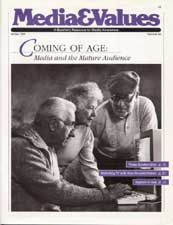TVs Dark Vision Can Be Frightening to Elders
|
This article originally appeared in Issue# 45
|
The issue of fear and concern about crime among the elderly is far more complex than earlier data suggests.
In the hit 1988 movie Crossing Delancy, a key scene shows heroine Izzy visiting her grandmother at a self-defense class for seniors. The fierce concentration of the elderly women students reflects their determination to protect themselves against purse snatchers and muggers.
In this case media reflects life: older people, among others, do take self-defense classes. But the scene also represents another phenomenon – the vulnerability and fears of older people, especially women, living isolated in urban neighborhoods. In Crossing Delancy, the media mirrors those fears. But in other cases, it may play a role in causing them. Recent research confirms earlier studies showing television's role in creating fearful viewers, but it also shows the relationship to be a complex one.
According to a long-held "cultivation hypothesis," heavy television viewing leads to a "mean world syndrome" that causes viewers to expect in reality the crime and danger they see on television. Older people were thought to be particularly susceptible for two reasons: one, they see themselves as particularly vulnerable; and two, TV's world itself depicts older people as being without value and often as victims of crime.
Recent research, however, shows only narrow support for this hypothesis. According to Crime News and Real-World Blues: A Panel Study of Social Reality, by researchers Garrett J. O'Keefe and Kathaleen Reid, 'There is no indication that overall television viewing or viewership of crime dramas has any impact on people's fear of crime, perceptions of its extent, or attitudes about self-protection."
However, the findings do provide narrow support for a more fearful view of the world by those who are heavy viewers of TV news. As researcher Reid describes it, "The telling argument here is that crime fear and concern appear to be shaped by televised crime news exclusively, not by crime news overall – at least not as presented in newspapers."
The primary difference is that when reading the newspaper, one tends to screen stories by scanning the headlines. Thus a person may selectively choose to read or not to read about a crime.
But when watching TV news, the viewer cannot select whether to watch or not watch a specific story. In addition, "live" reports from the scene of a crime and/or "blood and guts" reporting add to the emotional impact. Especially if a crime is particularly gruesome, the televised coverage may have a strong impact on viewers, young or old. "The way crime news is presented on TV, not the amount of crime per se, appears to be the culprit," she adds.
Although many older people fear crime, their view of themselves as potential victims varies, Reid notes. For example, most older people are aware that their danger of being burglarized is low. But their feelings of physical vulnerability often make them feel less safe than other citizens when out alone after dark. Evidently they believe, regardless of statistics, that people their age are more likely to be victimized; in fact, studies show that up to 25 percent of elderly women fear going out at night.
Media itself can be used to counteract its own negative effects, according to Reid. Public service spots, radio broadcasts and informational programs all have high potential for providing crime prevention information and training to vulnerable members of the audience, thus increasing mobility and reducing fear.



